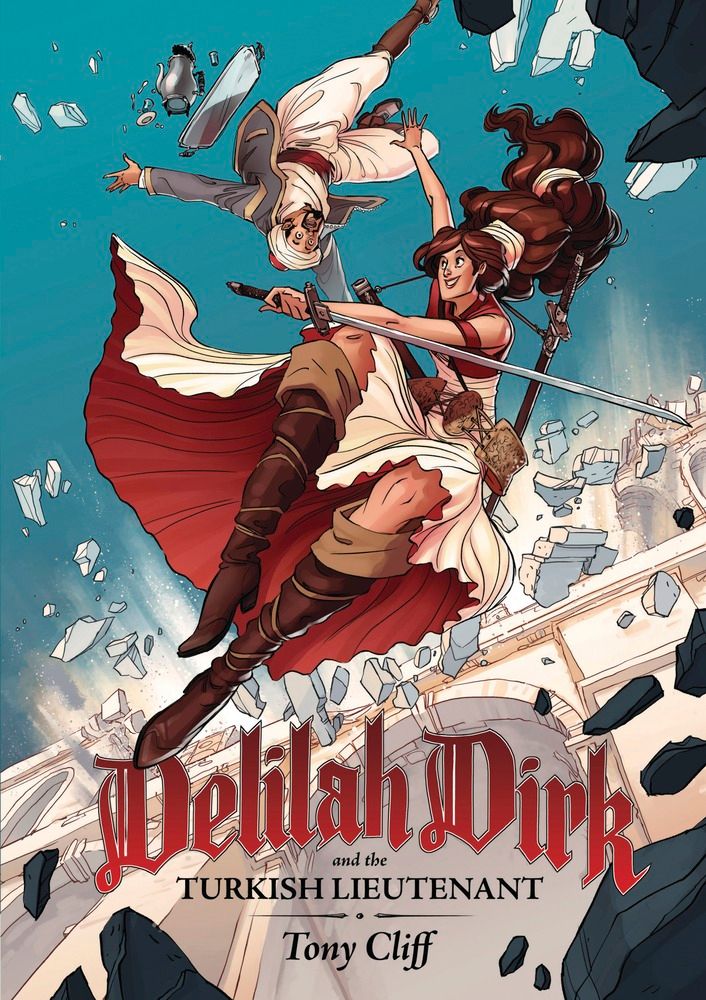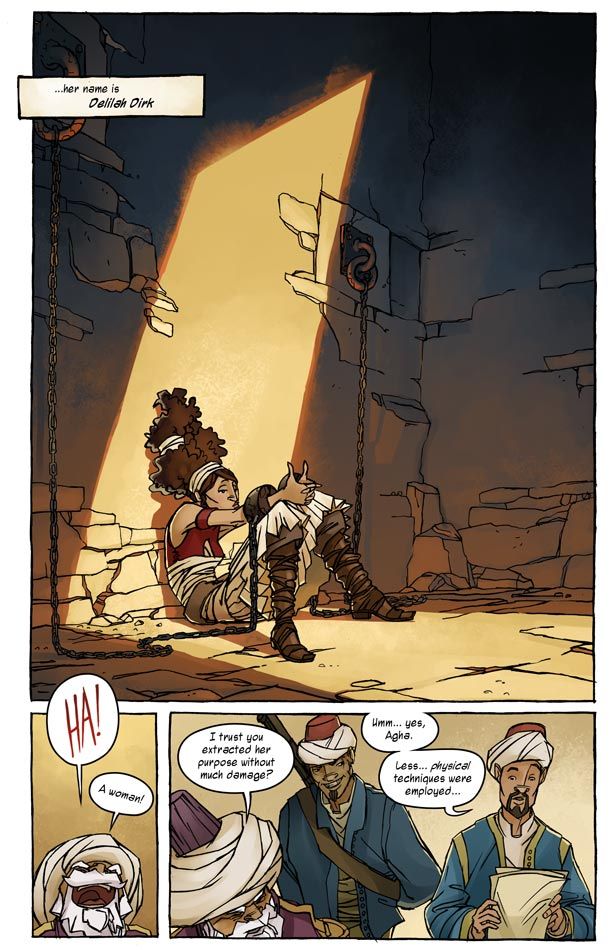Tony Cliff didn't have to escape jail, run from enraged armies or travel in flying ships to complete his debut graphic novel Delilah Dirk and the Turkish Lieutenant, but it wouldn't surprise me a bit if he had. The energy he invests in his story of a globetrotting, devil-may-care adventurer and the reluctant but noble soldier who inadvertently ends up tagging along suggests Cliff has a bit of the thrill-seeker in him, or at least in his pen.
Wanting to learn more about this former Flight cartoonist and his new book, I lobbed a bunch of questions to Cliff, who was nice enough to lob the answers back my way.
Robot 6: How did Delilah Dirk come to be? What was the original idea behind the character, and how did it change from the initial webcomic to Turkish Lieutenant?
Tony Cliff: It started off as a 30-page comic that I thought I’d put together just as a fun thing to do. I’d been reading a lot of Napoleonic War-era novels and wanted to make something in the same time period, with the sort of spirit I’d enjoyed in Indiana Jones and James Bond movies. Something fun, with a bunch of action and a variety of colorful settings.
I combined that first comic with a short story from the Flight anthologies, added a hundred pages to combine the two, and that became The Turkish Lieutenant as it appeared online. The print edition is more or less the same as the webcomic, though some of the text’s been finessed and there are roughly a dozen new pages of what has been described as “Delilah and Selim being cute in the woods,” a description whose accuracy I cannot dispute.
I was curious as to why you chose to set the story in the early 19th century, as opposed to another time period or creating a complete fantasy world all together. Do you have a particular affinity or affection for that era and the Ottoman culture?
I got really sucked into that time period, thanks to the Hornblower and Sharpe series of novels. I don’t remember if it was because of those or because of other influences, but I also became really interested in the histories of the Elgin Marbles and the Venus de Milo -- both cases where Western European interest in classical Greece created a lot of enthusiasm for ancient artifacts from the Mediterranean. I thought that arena could be mined for adventurous treasure-chase stories and perhaps a basic art history introduction. As I was looking through those books, I must have encountered some Victorian-era drawings of Turkey and Istanbul. I don’t know if I had a particular affinity or affection for Ottoman culture when I started this project, and I’m not even sure if I have a very solid conception of what Ottoman culture is, even now. I wouldn’t know how to distinguish it from Turkish culture in general. Unfortunately, I have yet to spend any time in Turkey. I’d like to do that, and find out how much or how little I actually do know.
I know from reading your blog that you're a stickler for historical research. Can you talk a little bit about the kinds of research you did for this book?
“Stickler” might be too strong a term. I’m enthusiastic for historical elements, and I like to absorb as much as I can, but historical accuracy is not a thing I feel is worth putting up too much of a fight over. I enjoy the way it adds some verisimilitude to otherwise fictional goings-on, but if I feel like some historical accuracy is putting a speed bump in an otherwise smooth story, I’d like to think I’d favor the story over the accuracy.
I research more or less constantly. Since this has been a real personal project, it’s not as though I look at the research as an unpleasant task -- it’s usually stuff I’m interested in. I mentioned the histories of the Elgin Marbles and Venus de Milo -- there are a pair of books that present their history in a very compelling narrative, and I’d recommend them to anyone even remotely interested (William St. Clair’s Lord Elgin and the Marbles and Gregory Curtis’ Disarmed: The Story of the Venus de Milo). A lot of my research for The Turkish Lieutenant came from a book called Beauties of the Bosphorus, written in the mid-1800s by Julia Pardoe, illustrated by William Bartlett. His illustrations provided a lot of my visual reference, in addition to paintings and drawings by Delacroix, Preziosi, and a whole load of others. I supplemented them with modern photos taken from Flickr, Panoramio, Google Maps and others. Just out of personal interest I started reading books like Orhan Pamuk’s Istanbul and Louis de Berniere’s Birds Without Wings, which ended up feeding subtle bits of influence into the project.
More often than not, though, I just find it’s very rewarding to dig into the research. If I’m working on a story and come to a point where I’m not sure where to go next or if I’m not happy with the solutions I’m coming up with, dipping into a bit of research can spark an idea. Maybe a little half-mentioned detail will fire up a whole entertaining solution to a story problem. The research can present options that I hadn’t considered. That always feels good, so I’ve become conditioned to enjoy the research.
Whenever any Western author deals with non-Western cultures, there's always the danger of being accused of giving into stereotypes or, god forbid, appropriating another culture's mythos or style for your own end. Were you conscious at all of those issues while making this book and if so how did you attempt to deal with them?
I was exposed to some of Edward Said’s Orientalism during art school, and I’m currently a hundred pages into a book written as a rebuttal to Orientalism, arguing against Said’s points. It is, to say the least, a sea of complicated issues, all this broad cultural interaction over the years. I think I have a modest understanding of the elements involved, and I don’t mean to dismiss or minimize anyone’s legitimate concerns when I say I honestly find the whole thing fatiguing. It’s not a “dialogue” (to use art-school terms) in which I’m interested in engaging, though I will acknowledge that Western Guy writing about Turkey implicitly means I’m involved, whether I like it or not. If we assume that Said and his detractors are each making valid scholarly points, then what are we left with? Two conflicting points about the East’s interactions with the West, two broad, opposing views of aggregate societies, each of which is partly true. Maybe wholly true to parts of the population and completely untrue for others. It feels so removed from actual human interaction and so couched in elaborate scholarly language and opinion that I would really prefer to leave those clever PhD candidates to duke it out among themselves.
I’ve just tried to approach The Turkish Lieutenant with a sense that the characters are individuals. I’ve tried to equip and portray them with as much depth as their role provides, and hopefully I’ve succeeded. I’m not sure what stereotypical attributes I might be inclined to give them if I were resorting to stereotypes, so I can’t say I’ve intentionally tried to avoid those. I’ve tried to be honest and do my due diligence. There are bound to be cultural biases and shortcomings of understanding, and I’ll be happy to listen to any constructive criticism anyone wants to provide. So far, the feedback has been supportive.
The next DD story will involve a lot of Regency-period England. I’m curious to see if anyone will be concerned about stereotypes or cultural appropriation related to that project (spoiler alert: probably not). I know as much about early-1800s England as I do about Turkey. I have had to research as much about England’s culture, religion and societal norms as I have for Turkey. I have ancestry that could probably be traced back to England, sure, but both my parents were raised in Canada as Anglicans or agnostics or something in between. For me, Regency England is only slightly less of a strange, exotic culture to than Ottoman Turkey. My current living experience is only slightly less removed from one than it is from the other.
That said, I’m no dummy. I understand that as long as a white guy sets out to portray what may traditionally seem like a foreign culture, there’ll be the question of cultural appropriation. White guys can write about England all they want without anyone thinking twice. I just hope I can do appropriate justice to whatever setting I’m writing about, no matter the background culture of the characters involved.
Were there any challenges in making the transition from web to print?
It was always my hope that The Turkish Lieutenant might become a printed graphic novel, so it was designed as such. I consider myself fortunate that First Second and Éditions Akileos (the book’s French publishers) shared a similar opinion. I serialized the book online because I needed to see whether this was a project that anyone would be interested in or whether this was the very picture of a vanity project. I needed to know whether it would be worth investing time and energy into a second Delilah story. If no one was particularly interested in the first one, then it would make more sense for me to invest my energies elsewhere.
Fortunately, it seems as though DD has managed to find an audience.
Delilah seems to draw not so much of Indiana Jones, as much as classic Hollywood films like Gunga Din and Captain Blood. What were your influences as far as creating this type of "classic adventure story"? Were there any cartoonists or comics you specifically drew upon?
I think all of the influences that got poured into Delilah Dirk were either movies, novels, or video games. Delilah herself is not exactly an Indiana Jones-type character, but there is a texture and feeling to those three movies that I tried to bring out in the comic. I wish I knew exactly how to articulate what that quality is, because that would make it a lot easier to judge whether I’d succeeded in getting it across.
I think any cartooning influences that I might have had would have come from Kazu Kibuishi and the Flight comics community. Those guys always had such a strong focus on honest storytelling that I can’t help but think I absorbed a bit of that. Both the first Delilah Dirk story and The Seeds of Good Fortune originated in a dumb little one-note joke. The Flight ethos always involved pushing genuine storytelling, and the community was always very good about providing constructive criticism for each others’ work. I developed a much more critical eye for my own stories as a result of my contributions to Flight, both the successful stories and the ones that didn’t make it into the anthologies. So while those DD stories might have started off as one-note jokes, they got spun off into what they are now. In both cases, the gags that I started off with didn’t survive the journey to finished pages.
Do you hope to turn Delilah Dirk into an ongoing series? Where do you see the characters and story going from here?
Definitely. I have a few stories in various stages of completeness to pick up where The Turkish Lieutenant leaves off. As for where they go, well, we’ll just have to wait and see. Meanwhile, I’ll be posting updates on the progress of the second book, tentatively titled The Blades of England, on a tagged subsection of my Tumblr, as well as on either my own kitchen-sink Twitter feed and the dedicated Delilah Dirk Twitter feed. Follow along at home!




